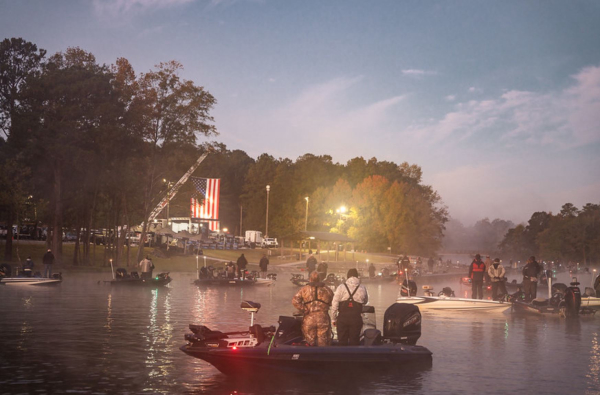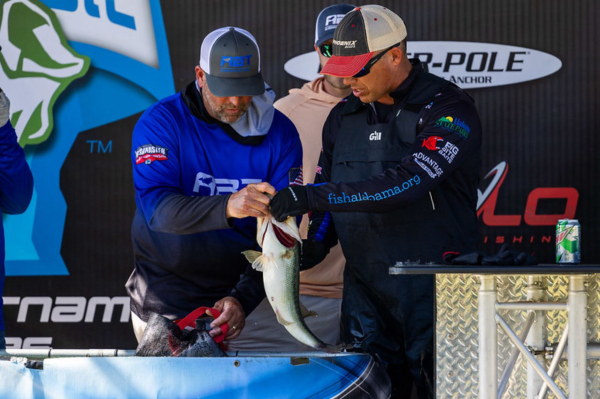
Hundreds of anglers turn out for major tournaments on the Coosa River lakes of Alabama—but would they continue to fish if a slot required release of 14” to 20” bass? (Alabama Bass Trail)
Lakes on the Coosa River, including from the north end Weiss Lake, Neely Henry, Logan Martin, Lay, Mitchell Lake and Lake Jordan offer wildly varying fishing opportunities. They’re loaded with crappies and catfish, sparse on bass of keeper size, even though they contain both largemouths and spotted bass in considerable numbers.
The lakes are highly fertile and thick with shad, so food is not the issue with bass growth.
Now, Alabama’s Department of Conservation and Natural Resources says tournament fishing could be part of the problem, particularly during summer months—and they have floated a controversial fix.
While bass tournaments have always vowed that fewer than 10 percent of fish weighed in at their events die as a result, ADCNR just completed a new study with Auburn University on these lakes that show up to 43 percent die year around, with over 50 percent dying after release in the hottest months, and that tournament fishers catch the vast majority of quality fish in these lakes.
Alabama DCNR is exploring management options, including a controversial but likely effective plan for a no-harvest slot limit for bass from 14 to 20 inches long—in other words, what now constitute “keepers” would not be allowed in the boats.
If the proposal goes through, tournament proponents say it could be the end of many major bass tournaments and the money they generate for local economies in northeast Alabama.
Too Much Pressure on Smaller Lakes?
Damon Abernathy, Assistant Chief of Fisheries for the state, says the issue is that the lakes are relatively small, and the tournament pressure is enormous.
“These lakes average around 15,000 acres and they get swarmed by major tournaments just about every weekend of spring, summer and fall, and that’s just a huge amount of pressure on the fishery. And a lot of these fish, especially in summer and early fall, have to ride around in the live wells with water temperatures over 80 degrees, and they just don’t make it, even if they’re still kicking a little at weigh in, the mortality after release is very high.”
By comparison, Lake Guntersville on the Tennessee River—which also draws hundreds of tournaments each year—is 69,000 acres and seems to absorb the pressure pretty well, with occasional ups and downs more related to water levels and shad spawns than to tournament by-kill.
Currently, the state has no minimum size limit on largemouths and spotted bass in most lakes, and the limit on most waters is 10 fish per person, so technically tournament anglers could be catching and killing a whole lot more fish and still be legal.
However, bass anglers in general just don’t keep fish. And most anglers around the Coosa River lakes would like to see the fishery improved with better odds of catching more and larger bass.

Bass are carried from boat livewells to on-stage weigh-ins in soft bags full of lake water to reduce mortality, but in the heat of summer survival may plunge. (Alabama Bass Trail)
Abernathy says the lakes are highly fertile and have plenty of shad to feed the bass, and he’s confident if the tournament pressure is relaxed, the fishery will soon be booming.
Making it a lot better would be a boon, but it would take four or five years to see the benefit of the shutdown as many of those fish not being caught and dying after weigh-ins would grow to become larger fish.
Tournament organizers and lakeside communities that make money from the competitions are naturally opposed to a shutdown. While putting an end to tournament weigh-ins of slot fish would solve the problem, it would also put an end to a lot of tournaments or result in organizers moving to other lakes. The highly successful Alabama Bass Trail, in particular, schedules multiple events on the river lakes.
And if the lakes were re-opened to conventional tournaments at the end of five years, the quality fish would soon be caught, weighed in and released to die once again, so the lakes would be back where they started.
Time for Catch/Record/Release?
However, the sort of catch/measure/weigh/release format used in MLF and in many kayak tournaments might be one solution. Bass are either measured or weighed on calibrated digital scales in the boat immediately when caught, photographed and then sent back over the side where they were caught—survival is nearly 100 percent.

The on-stage weigh-in is a dramatic moment in a big money tournament. Would crowds still turn out for catch/weigh/release events? (Alabama Bass Trail)
The downside of that, and it’s a big one, is that there’s no dramatic weigh-in at the end to draw a crowd, and unless the events are televised or streamed, no benefit to potential sponsors to boost prizes and sponsorships.
Alabama DCNR says everyone will get a chance to have a say at meetings slated for locations around the watershed this year, so those who feel strongly about the slot limit management either way (and there are apparently a bunch!) will have a chance to get their say.
Check https://www.outdooralabama.com for updates.
— Frank Sargeant
Frankmako1@gmail.com
Perhaps the greatest benefit of this regulation would be to increase voluntary participation in catch-weigh-release tournament formats. This would allow tournament organizations to credit its competitors with catches of all fish within the protective slot limit. Their immediate release following the catch and weighing would reduce tournament mortality to near zero.”